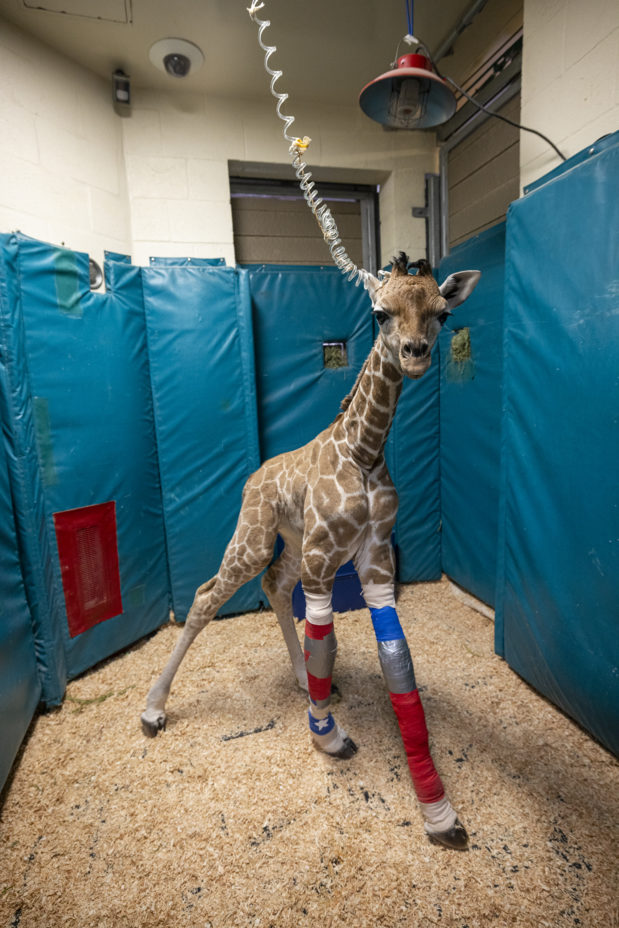Three-month-old Giraffe Calf Thrives Following Unique Orthotic Leg Brace Treatment
A three-month-old giraffe calf at the San Diego Zoo Safari Park has received a new lease on life, thanks to swift intervention by the conservation organization’s wildlife health and wildlife care teams to correct abnormalities that threatened the calf’s survival. The female youngster—named Msituni (pronounced see tune neee), which means “in the forest” in Swahili— received a pair of specialized giraffe-patterned orthotic braces that attached to her front legs to help correct a hyperextension of the carpi, bones that are equivalent to those in the human wrist. This disorder had caused the giraffe’s front legs to bend improperly, and made it difficult for her to stand and walk. Wildlife care staff said Msituni’s chances of survival would have been very low without the treatment provided by the San Diego Zoo Wildlife Alliance team in collaboration with orthotists from Hanger Clinic.
“We are so glad to have the resources and expertise to step in and provide this young calf the opportunity for a full life,” said Matt Kinney, DVM, senior veterinarian at the San Diego Zoo Safari Park. “Without these lifesaving braces to provide support, the position of her legs would have become increasingly more painful and progressed to a point she would not have been able to overcome.”
The custom orthotic braces were crafted by Hanger Clinic, a nationwide provider of outcomes-based orthotic and prosthetic (O&P) care. While the company focuses on O&P care for humans, members of the San Diego-based Hanger Clinic team consulted with wildlife care staff to develop a customized plan specific to Msituni and her case. Following initial device fittings, the team quickly fabricated the custom-molded carbon graphite orthotic braces by using cast moldings of the calf’s legs and fit Msituni with her new devices, complete with a giraffe pattern to provide a more natural look.
“I feel a tremendous sense of accomplishment,” said Ara Mirzaian, certified orthotist at Hanger Clinic. “I’ve never worked with wildlife before—it’s one of those things that is a once-in-a-lifetime opportunity, and you just have to savor the moment.”
Apart from the irregularities in her front legs, Msituni suffered a variety of serious ailments following her birth. Wildlife health staff treated her using intravenous antibiotics for abnormalities in her blood and provided specialized hoof extenders to fix the irregular position of her back legs. Ultimately, the treatments were a success: Msituni is no longer receiving antibiotics, the braces have been removed, and her legs are now correctly positioned—which is leading to her attaining a healthy weight and height.
The calf has done so well, the wildlife care team introduced her to the rest of the giraffe herd in the Safari Park’s 60-acre East Africa savanna habitat, including another adult female, named Yamikani (pronounced ya me caanee), and her female calf, Nuru (pronounced nu roo). Nuru was born four days after Msituni.
“This was an important step in Msituni’s natural development,” said Kristi Burtis, director of wildlife care at the San Diego Zoo Safari Park. “As her bond grows with the herd, she will be able to learn behaviors and skills important to the development of a young giraffe.”
Science teams have estimated that fewer than 100,000 giraffes are left in their native habitats—a decrease of more than 40 percent over the last 20 years. It is believed that the downward trend is due to habitat loss, habitat fragmentation and poaching in certain regions. San Diego Zoo Wildlife Alliance has partnered with numerous conservation organizations on large-scale conservation projects, in an effort to slow and eventually stop the continued decline of giraffe populations.
“The birth of every animal is a cherished event, and Msituni’s survival in the face of so much adversity makes it all the more remarkable,” said Kinney.

Category: Animals, Local News, Nonprofit







